"Energy Subsidy Reform: The Way Forward" Presentation by David Lipton, First Deputy Managing Director, International Monetary Fund
March 27, 2013
March 27, 2013
As prepared for delivery
Thank you for giving me an opportunity to be here today to present the key findings of a new IMF study on energy subsidies. That study will be published today on the IMF’s website, including in Arabic and French.
Over the decades, the subject of energy subsidies has evoked the image of oil producing countries that offer cheap gasoline and fuel to their people. In recent years, we have been hearing about countries that are finding that the fiscal weight of energy subsidies is growing too large to bear. In some countries budget deficits are becoming unmanageable and threatening the stability of the economy. Where political systems have generated large and growing subsidy burdens, in part to placate restive populations, countries now find they suffer both fiscal paralysis and energy shortages. Headlines from countries like Egypt and Pakistan have focused on the need to address this burden that could jeopardize fiscal sustainability and balance of payments viability. In many others, subsidies remain a stumbling block to higher growth by squeezing out much needed health, education and infrastructure spending. Twenty countries now maintain energy subsidies that exceed 5 percent of GDP.
But as I will explain, energy subsidies are a wider and more pervasive problem, with major consequences for many individual countries, but also for the global economy and the environment. The G20 acknowledged this point at the Pittsburgh Leaders Summit in 2009, and pledged to eliminate all inefficient fossil fuel subsidies over the medium term. I do not know exactly what constitutes the medium term, but it is surely time to get on with fulfilling this very important commitment.
Subsidies are an issue in practically every country in the world. Pre-tax subsidies, which arise when energy consumers pay less than the supply cost of energy, are high in many emerging and developing economies, and have risen in recent years due to limited pass- through of increases in international energy prices to domestic consumers. Although pre-tax subsidies are not a large enough problem in advanced economies to cause fiscal difficulties, these countries have tax subsidies, where the taxes imposed on energy are not high enough to account for all of the adverse effects of excessive energy consumption, including on the environment, in other words, where externalities are not addressed.
The issue of energy subsidy reform is not new. Indeed, in several cases, the IMF and country authorities have been discussing potential reforms for several decades. Despite widespread recognition of their adverse consequences, energy subsidies have proven difficult to reform. The surge in international energy prices in recent years has drawn further attention to this issue, including as I mentioned from the G-20. And the link between subsidies, consumption of energy, and climate change has added a new dimension to the debate on energy subsidies. My presentation today will cover three broad topics: first, the consequences of energy subsidies; second, the magnitude of these subsidies; and third, the ingredients for successful subsidy reform.
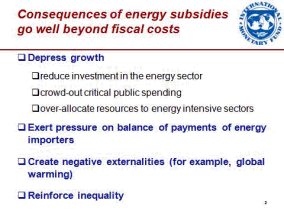
Let’s turn now to the first topic (Slide 2). The consequences of subsides go far beyond their fiscal costs. Let me review the numerous channels through which the adverse effects of subsidies are felt.
First, low and subsidized prices make it unattractive for the private sector and state-owned enterprises to invest in the energy sector to expand production. This reduces the supply of energy, a critical input for growth. In Africa, for example, the losses incurred by electricity suppliers due to subsidized prices have severely constrained their ability to invest in new electricity capacity and improve service quality. As a result, installed per capita generation capacity in sub-Saharan Africa, excluding South Africa, is about one-third of that of South Asia and one-tenth of that in Latin America.
Second, subsidies crowd out public spending that can boost growth, including on infrastructure, education, health care, and the social safety net. Some countries spend more on energy subsidies than on public health and education, undermining the development of human capital.
Third, subsidies result in the misallocation of resources to capital- and energy-intensive activities, with overuse of subsidized technologies. Subsidy reform can lead to a more efficient allocation of resources, which will help spur higher economic growth over the longer term. Removing energy subsidies can also help prolong the availability of nonrenewable energy resources and strengthen incentives for research and development in energy-saving and alternative technologies.
Fourth, by increasing energy consumption, subsidies exert pressure on the balance of payments of net energy importing countries.
Fifth, again by boosting energy consumption and thus emissions, subsidies aggravate climate change and worsen local pollution and congestion. Our estimates indicate that subsidy reform could play a significant role in offsetting climate change. Eliminating pre-tax subsidies alone would reduce CO2 emissions by about 1-2 percent. For comparison, if countries implemented emissions reduction pledges made in the 2009 Copenhagen Accord, global (greenhouse gas) emissions in 2020 would be reduced by 7 percent below levels that would otherwise occur if lenient targets were met. In other words, about 15-30 percent of a key global emissions reduction goal can be achieved just by stopping to encourage excessive energy use via pre-tax subsidies. And the gains from tackling post-tax subsidies would be even larger, as this would reduce CO2 emissions by 4½ billion tons, a 13 percent reduction. This amount is significant, even when viewed alongside the objectives of the global climate change negotiations. These estimates point to the substantial benefits of using fiscal instruments to achieve climate change objectives. The time has come for subsidy reform and carbon taxation.
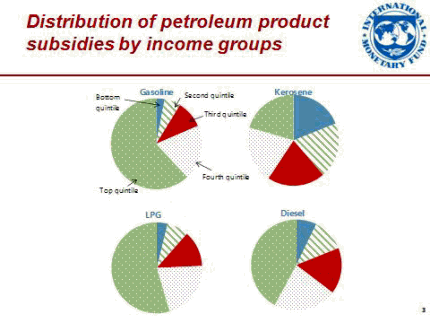
Finally, energy subsidies reinforce inequality because they mostly benefit upper-income groups, who are the biggest consumers of energy. For example, in the case of electricity subsidies, a large majority of the poor in Africa receive no benefit at all because they are not even connected to the electricity grid. Moreover, because most subsidies are conveyed by controlling prices, the subsidy you receive is related to how much energy you use. So it is no wonder that the greatest beneficiaries are those with cars and air conditioned houses.
On average, the richest 20 percent of households in low- and middle-income countries capture 43 percent of fuel subsidies (Slide 3). Nevertheless, a sharp increase in energy prices can still have a significant impact on the poor, which means that it is essential to put in place mitigating measures to protect them as subsidy reform is implemented.
Let me turn to the second topic, the magnitude of energy subsidies by region and product Our figures are based on comprehensive estimates of fuel energy for 176 countries and cover petroleum products, electricity, natural gas, and coal for 2011. We do not cover subsidies for renewable energy because they involve a small share of energy use and disaggregated data by country are not widely available.
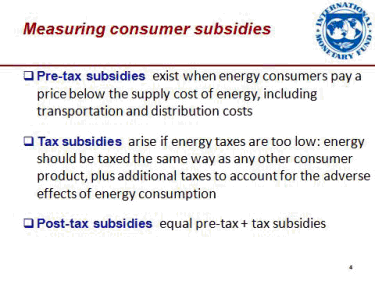
Before discussing the figures, let’s first briefly define consumer subsidies (Slide 4). We estimate both pre- and post-tax subsidies. Pre-tax subsidies arise when energy consumers pay less than the supply cost of energy, including transportation and distribution costs. Tax subsidies arise if energy taxes are too low. Under efficient taxation, energy should be taxed the same way as any other consumer product, plus an adjustment for negative externalities such as the effect of energy consumption on climate change, local pollution, and congestion. Post-tax subsidies equal the sum of pre-tax and tax subsidies. Beyond consumer subsidies, our figures also try to capture producer subsidies. These arise if state-owned enterprises in the energy sector make financial losses not because of low prices to consumers, but because they are inefficient.
Let’s now turn to the figures (Slide 5). Pre-tax subsidies are substantial, at 0.7 percent of global GDP, or about 2 percent of global tax revenues. They mostly comprise subsidies for petroleum products and electricity.
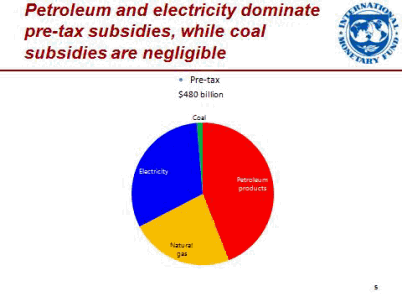
In terms of their regional distribution, the Middle East and North Africa region, or MENA for short, accounts for about half of pre-tax subsidies (Slide 6).
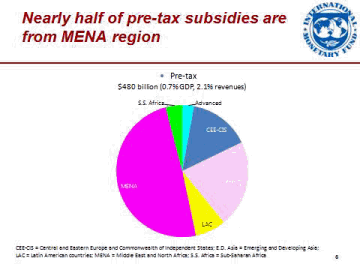
Also, in terms of regional GDP and government revenues, pre-tax subsidies are highest in MENA, reaching 8.6 percent of GDP and 21.8 percent of government revenues (Slide 7).
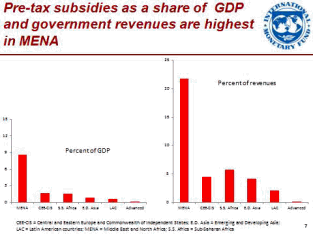
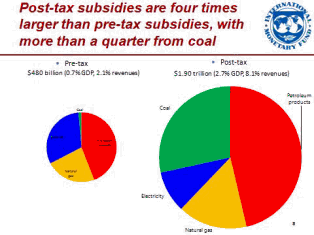
And when we look at post-tax subsidies, the full magnitude of subsidies is alarming (Slide 8). They are four times as large as pre-tax subsidies, with more than a quarter devoted to coal. Worldwide, post-tax subsidies are estimated to be 1.9 trillion dollars. This is the equivalent of 2.7 percent of global GDP, or 8 percent of government revenues.
The global distribution of post-subsidies is very different from what we have seen for pre-tax subsidies. In fact, advanced economies account for 40 percent of the global total (Slide 9). All advanced economies are providing energy subsidies on a post-tax basis. Throughout the world, some 159 economies are subsidizing energy, underscoring that energy subsidy reform is truly a global challenge.
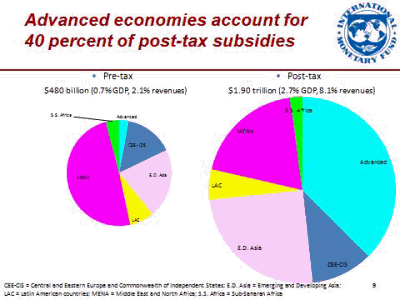
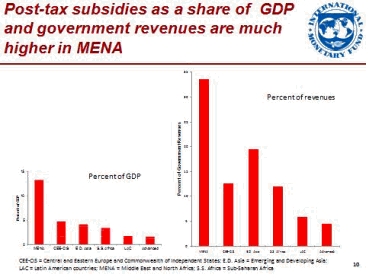
There are substantial differences in the size of subsidies relative to regional GDP and revenues (Slide 10). As a share of GDP, post-tax subsidies are highest in MENA and lowest in the advanced economies. As a share of revenues, subsidies are much higher in MENA and emerging and developing Asia than in other regions. Yet, in absolute terms, the top three subsidizers across the world are the United States (US$ 502 billion), China (US $279 billion) and Russia (US$ 116 billion).
Across all regions, under-pricing for externalities accounts for a large share of post-tax subsidies (Slide 11).
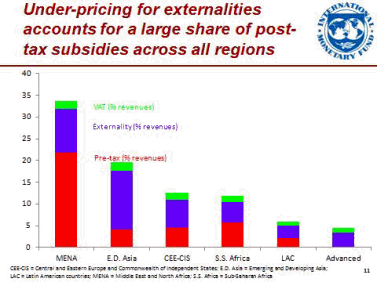
In sum, energy subsidies are large on a global scale, and they are by no means an issue only for emerging and developing countries.
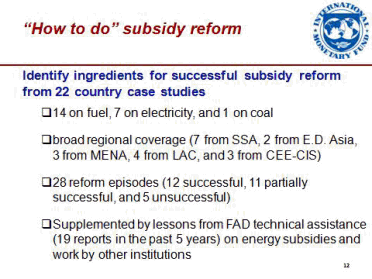
I would now like to turn to my third topic, the ingredients for successful energy subsidy reform.We identified the ingredients for successful reform from 22 case studies of subsidy reforms (Slide 12). These comprise cases of reform of petroleum, electricity, and coal subsidies, and cover a broad range of countries across different regions. We examined instances of success and also those that were partially successful or unsuccessful. This was supplemented by lessons gained from the IMF’s technical assistance on subsidy reform and insights from the work of other institutions. The case studies underscore that there are a number of good examples that could be emulated, such as the Philippines and Turkey on petroleum products, and Kenya and Uganda on electricity.
We found that there are six key ingredients to successful subsidy reform (Slide 13). First, public support can be gained by spelling out a comprehensive reform plan. This should include clearly articulating its long-term objectives, such as achieving full price liberalization and improving the quality of services. In the Philippines and Turkey, for example, full price liberalization and structural reform of the energy sector, for both fuel and electricity, were articulated as the ultimate goals of reform. This allowed the public and governments to focus on and adhere to long-term goals.
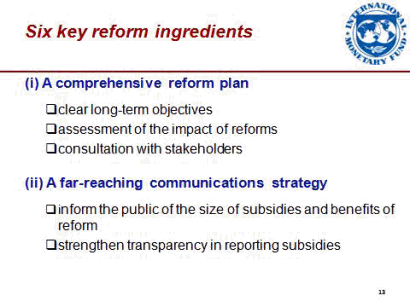
Designing a comprehensive subsidy reform strategy also requires information on the fiscal and macroeconomic effects of subsidies and identifying the winners and losers from reform. In Ghana, in 2005, the government commissioned an independent poverty and social impact analysis to assess the winners and losers from fuel subsidies and subsidy removal. This was an important step toward persuasively communicating the need for reform and for designing policies to reduce the impact of higher fuel prices on the poor.
Stakeholders should be consulted and invited to participate in the subsidy reform strategy. This “stakeholder approach” has proven successful in a number of countries. In Kenya, for example, resistance to electricity tariff increases was overcome after intense negotiations with stakeholders, particularly with large consumers, and efforts to communicate the objectives and benefits of the reform.
The second element in successful subsidy reform is a far-reaching communications strategy. This involves informing the public of the size of subsidies and the potential benefits of subsidy reform, for example, the scope to raise priority spending in the social sectors. Information campaigns have underpinned success in this regard in a number of countries, including fuel subsidy reforms in Namibia and the Philippines, and electricity subsidy reforms in Armenia and Uganda.
Strengthening transparency is also a key component of a successful communications strategy. It is particularly important to disseminate information on the size of subsidies and how they are funded. This is especially relevant for oil-exporting countries, where subsidies are provided implicitly and not shown in the budget or recorded as tax expenditures. Subsidy expenditures should also be compared to spending on priority areas, as well as to the planned increases in these outlays that result from the additional revenue freed up as a result of subsidy reform. Governments should also disclose as much information as possible about how prices are formulated and the factors behind planned price increases. Both Ghana and South Africa regularly publish such details for petroleum products on their government websites and in the national media.
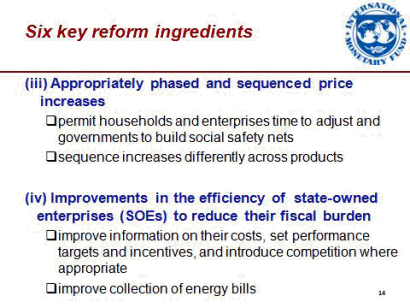
The third element in successful subsidy reform is appropriately phased and sequenced price increases (Slide 14). The phasing of price increases for a particular country will depend on a range of factors, including the size of the price increases required to eliminate subsidies, the fiscal position, and the political and social context in which reforms are being undertaken. Phased increases allow time for households and governments to adjust their consumption of energy. They also give governments the time to expand and strengthen social safety nets. A slower pace of reform, however, reduces budgetary savings in the short term. There is therefore a trade-off between the objectives of achieving budgetary savings and softening the impact of reforms on households.
Price increases can be phased across different products. For example, price increases can initially be larger for products consumed more heavily by upper-income households, like gasoline. As the safety net is strengthened, subsequent rounds of reform can include larger increases in prices for fuel products that are more important in the budgets of the poor.
The fourth component of a successful subsidy reform strategy is improvements in the efficiency of state-owned enterprises to help reduce their fiscal burden. This can be accomplished by improving information on their costs, and armed with this information, setting performance targets and incentives. It can also be helpful to introduce competition to help improve performance.
There is also scope to improve the collection of energy bills, especially in electricity.
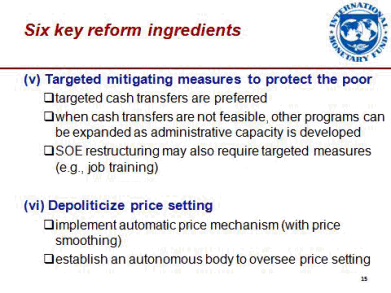
The fifth element in successful subsidy reform, and in some ways the most critical, is to implement mitigating measures to protect the poor (Slide 15). Targeted cash or near-cash transfers, such as vouchers, are the preferred approach. Cash transfers give beneficiaries the flexibility to purchase the amount and type of energy that best suits their needs, or to buy other goods and services. They also remove the need for governments to be directly involved in the distribution of subsidized energy to households, which is often extremely costly and prone to abuse. When cash transfers are not feasible, other programs can be expanded while administrative capacity is developed. This should focus on existing programs that can be expanded quickly, possibly with some improvements in targeting effectiveness. Some examples include school meals, public works, and subsidized urban transport. In Ghana, these measures also included the elimination of fees for state-run primary and secondary schools.
The restructuring of state-owned enterprises may require sector-specific supporting measures. Policies that mitigate the impact on workers and promote restructuring can increase support for subsidy reform. In the case of coal sector reform in Poland, for example, unemployed miners had access to social assistance and job training.
Finally, the sixth ingredient of a successful subsidy reform strategy is to depoliticize the setting of energy prices. This is necessary to make reforms durable. It can be facilitated by implementing an automatic price mechanism, with a smoothing rule incorporated to avoid sharp increases in domestic prices. Responsibility for implementing the automatic mechanism can be given to an independent body.
To sum up, the bottom line is that energy subsidization is a major problem, but one that can be solved. Subsidies have adverse effects on public finances, economic growth, equity and the environment. Reducing subsidies is not easy, but many countries now see the benefits of doing so and intend to try. With adequate planning, carefully designed mitigating measures, and a good communications plan, the job can be done. Indeed, some have already succeeded. The IMF will draw attention to the issue and help those who want to go forward. Our mantra will be: subsidy reform is needed, but it is better to do it the right way, than to do it right away.
Thank you very much.
IMF EXTERNAL RELATIONS DEPARTMENT
| Public Affairs | Media Relations | |||
|---|---|---|---|---|
| E-mail: | publicaffairs@imf.org | E-mail: | media@imf.org | |
| Fax: | 202-623-6220 | Phone: | 202-623-7100 | |


